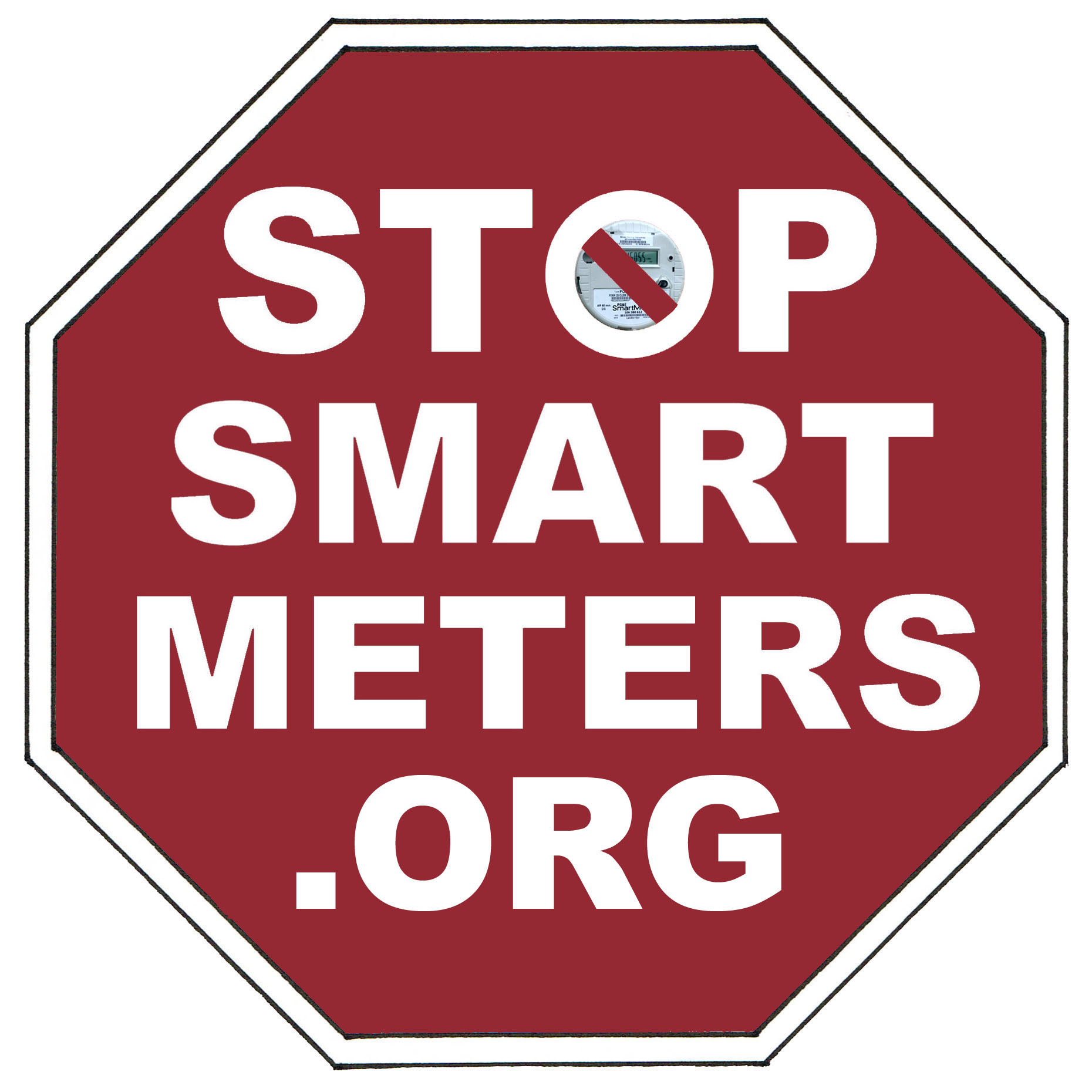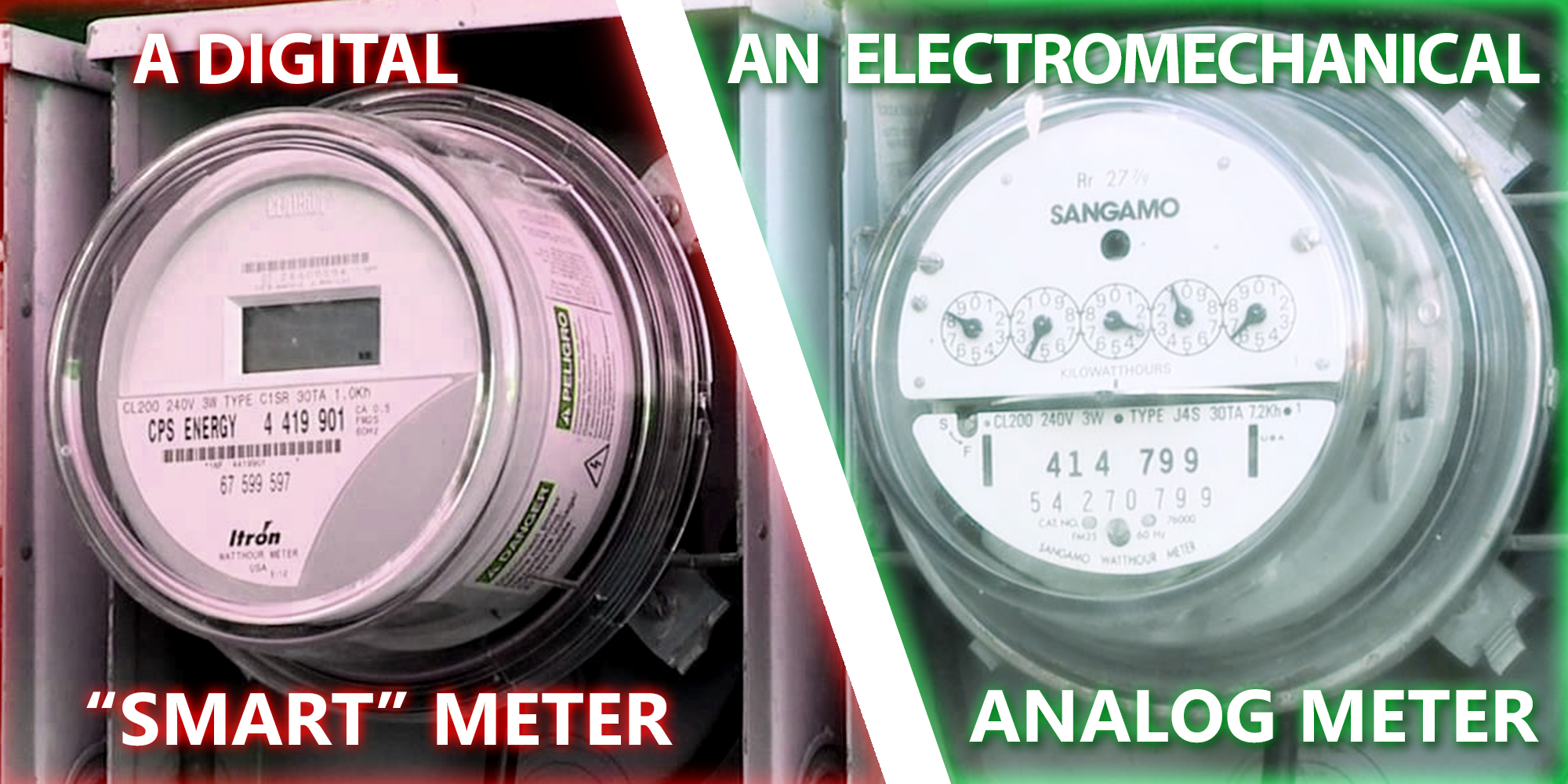WHY UTILITY CLAIMS OF ENERGY SAVINGS FROM SMART METERS
ARE NOTHING MORE THAN “GREEN-WASHING”

Smart meters may substantially increase greenhouse gas emissions as well as customer bills- Alexander Binik explains why...
By Alexander Binik
The huge costs for PG&E’s (and other utilities’) smart meters programs are paid for either completely by the ratepayers (in PG&E’s case) or by a combination of ratepayer charges and federal tax dollars. The utilities’ primary justification for these ultra-expensive public expenditures is their claim that the new meters will be used by customers to substantially reduce energy use and/or to shift use to night-time hours (thus decreasing the use of “peaker” electricity plants). In either case, supposedly the smart meters will help slow down global warming.
Has PG&E conducted any pilot studies to determine whether these predictions are based in reality?
NO! In 2008, when PG&E first proposed shifting over to a $2.2 billion system of mesh-networked wireless microwave-pulsed meters, the San Francisco Department of the Environment and the San Francisco Public Utilities Commission jointly issued a report charging that savings from the digital-metering system simply would not cover its increased costs to the public. The San Francisco report for the Board of Supervisors quoted negative tests from across the United States and Canada, while warning that a large-scale system attempting all the advanced features pledged by PG&E has never been tested anywhere. The SF critique strongly recommended that PG&E be required to conduct a 500,000-unit pilot program before rolling out Smart Meters to all its customers. The CPUC was urged to reject any additional smart-meter costs “until the proposed upgrades can be proven to be cost effective and deliver on the promised benefits.”
However, no such pilot project of PG&E’s new system ever was carried out. The California PUC Division of Ratepayer Advocates and The Utility Reform Network watchdog group further chimed in with objections that PG&E’s energy conservation claims were overstated. Nevertheless, PG&E has NOT conducted a single pilot study to test its assumptions. And the CPUC, shirking its duty as a regulatory agency, has not required any such studies before approving PG&E’s request to force each customer to accept the new meters and pay for them (billions of dollars already, and the cost is still mounting).
Is there evidence from other regions to support PG&E’s predictions of increased customer energy conservation?
NO again! Because smart meters are a new phenomenon worldwide, there has been little opportunity to date to evaluate such predictions with actual usage statistics. But a recent research report (from Lower Carbon Futures, the Environmental Change Institute at Oxford University) informs us that “little evidence exists to show overall demand reduction”.
A recent extensive report, jointly issued by national nonprofit organizations including Public Citizen and AARP, looked through hundreds of utility dockets and found that there is no significant evidence of sustained overall energy conservation due to use of AMI (the technical name for smart meter programs).
In fact, the only study to date of an actual wireless smart meter system’s energy conservation outcomes was of the system in Toronto and environs in Canada. That 1-year study of 10 thousand households showed no significant energy conservation on a per-household basis; indeed, if the system-wide energy costs for manufacturing, installing and maintaining the system were factored in, there could well have actually been an increase in overall carbon footprint.
However, in this study, the resulting increase in customers’ energy bills was indeed quite significant—80% of households have been paying higher rates than before smart meters were installed; and this is in addition to customers having paid the huge costs of installing the smart meter infrastructure. This jibes with conclusions in the report from Public Citizen et al, that.
What about the likelihood of smart meters facilitating time-shifting of electricity use away from periods of high demand?
Utilities sometimes claim that smart meters constitute an effective tool for “load management” (i.e., customer usage time-shifting to generate peak load reduction), aimed to reducing CO2 emissions by reducing the building and use of “peaker” plants. About this, the Public Citizen report says: “ Residential customers can deliver the same or similar level of peak load reduction if promised a rebate or credit compared to the customers who were on critical peak prices. Furthermore, the objective of obtaining a significant level of peak load demand reduction can be met without an expensive new metering system.”
To the best of our knowledge, there have not been any deployed mandatory AMI systems for which substantial peak load reductionwas achieved and maintained for a significant period of time. Nor have there even been long-term pilot studies for this situation in which everyone received a smart meter and time-of-use of dynamic pricing was used. Again, there’s no evidence to date suggesting that a smart meters system will make any significant inroads in this direction.
Differential time-of-use electricity rate schedules are already available as an option for customers without the need for smart meters. With a smart meter system, a sufficiently-motivated customer could seek electricity usage data online, but could only access overall household usage statistics…and for periods 24 hours prior or earlier. One would have to keep very-careful personal records to track what was in use at that time and compare it with usage at other earlier times when perhaps the TV or dishwasher hadn’t been in use. Typically, the maximum savings from time-shifting would total no more than a few dollars a month, hardly enough to motivate large-scale behavior change. Using time-of-use rates will continue to be voluntary, so they won’t have any effect on those most energy-profligate. Indeed if such rates ever became compulsory, that would greatly penalize the poor and people whose schedules require greater electricity use during the daytime hours. (The above-mentioned report–by Public Citizen, AARP, Consumers Union et al–expresses grave concerns about potential harmful impacts of moves toward time-based or dynamic pricing.) And certainly, on a hot day no one is going to shift use of an air conditioner to night-time.
It’s true that eventually smart meter systems will inaugurate a later phase that can provide near real-time data about electricity use from various appliances in the home, but the additional financial costs, energy consumption, and wireless radiation required by such systems will make them anathema to most customers. And (as discussed below) even when they are used, they’re likely to actually increase total electricity use rather than decrease it.
What kind of alternative exists to truly encourage electricity conservation? Only a tiny fraction of the money spent on smart meters could be used to provide each household with a small portable energy usage meter. (For example, amazon.com sells a plug-in Kill-a-Watt meter for just over $27 total price (including shipping). To determine how much energy a particular appliance or piece of electronics uses, one simply plugs the meter into a wall outlet, then turns on the device after plugging it into the meter; result: immediate device-specific information that the customer can then use to influence future decisions. One of the most significant contributors to a typical customer’s electricity usage is what is known as “phantom” (or “vampire”) loads, that is, the continuous and significant usage due to things just being plugged into the wall outlet. This is particularly true for instant-on electronics, chargers kept plugged in, etc. An highly-experienced energy conservation specialist recently reported: “In a recent energy survey for a home in Redwood City, I found that the phantom electrical loads for the family’s home theater system (when the system was actually off but still plugged in!) was in fact greater that the combined electrical usage of their two refrigerators.” Using a simple Kill-a-Watt meter, a customer could quickly learn how much energy is being wasted in this way, and instead switch off the power strips into which these devices have been plugged. This simple change can collectively save a lot of energy. Customers can be further motivated by utility-provided rebates for cutting electricity usage by a certain percentage. (Alternatively, a device called a TED meter can be installed to give detailed usage information; but, for most customers, this more-expensive meter—which would need to be installed by an electrician–would be overkill compared to the Kill-a-Watt.)
And, for 99% of customers, a cheap and effective approach to encourage time-shifting would be to provide each household with a refrigerator magnet giving an estimate of how much could be saved by shifting prime-time appliance use at each later hour of the day. Most people do not even read or understand their phone bill. A magnet on the refrigerator–telling the relative wattage per hour usage of various appliances and electronic devices–would be far more user-friendly for nearly all customers than having to go online, check past usage information, and remember what combination of appliances and devices were in use at any given time.
Say more about the likelihood that, overall, smart meter systems can actually increase overall electricity use.
To utilize the system that will provide real-time data for individual appliances, the consumer will need to purchase expensive new appliances containing built-in wireless transmitters and receivers. They would also have to install a “Home Area Network”, including a wireless router which sends a powerful signal 24/7. All connected appliances will be sending information to the smart meter, to be bounced from there via all the surrounding meters to the utility’s data collector device and eventually to the regional office. All these levels will add considerably more electricity usage that is not needed currently. Besides the energy required for data transmission (and repetition), even the internal meter electronics (especially the switching power supply) consumes energy 24/7, effectively acting as yet another “vampire” device at each service location. (Keep in mind that, in PG&E’s service territory alone, many millions of smart electric meters will be operating simultaneously, not to mention all the smart gas meters and water meters that will soon be joining them.)
In addition, these pulses of data (PG&E predicts they will be every 8 seconds) will collectively require storage (in a form available for online access 24/7) of absolutely huge amounts of information. (A U.S. utility industry newsletter estimates that by 2015 annual smart meter data storage requirements will climb to 35 petabytes, where 1 petabyte=1 billion megabytes.) The storage and server equipment required for this will operate 24/7 and will itself require a tremendous increase in electricity usage.
To make the energy accounting complete, we need to not forget the contributions to overall carbon footprint by externalities such as the manufacture, shipment and installation of all these meters, as well as the collection and disposal of still-functional analog meters. (Will they be landfilled close to home, or shipped to Asia for disposal there?) It is true that there will also be a reduced contribution to carbon footprint by virtue of less need for on-site meter-reading; however, this energy cost could be mostly eliminated by offering a program wherein users of electromechanical analog meters have their monthly bills estimated, with on-site readings only twice a year when the rate structure changes seasonally.
Factor in all these various elements, and it is exceedingly likely that overall carbon footprint will rise, not fall. We can be certain that the utilities—while busily touting their predictions of reduced peak electricity consumption due to smart meters–will ignore these additional energy costs that would be part of a more honest accounting. Hopefully environmentalists and others will see the truth below the veneer of the utilities’ “funny math”.
Please say a bit about the Smart Grid.
The Smart Grid is a grand concept that includes helping getting electric power from where it’s produced to where it’s needed, It is true that more advanced infrastructure and design certainly can be helpful in making the overall grid more efficient and reliable. But these improvements can easily be made without any need for monitoring individual customers’ usage 24/7. It is also the case that—if connections to customers’ homes were indeed needed (they are not!)—wired fiber optics could be used, extending all the way from the substations to the individual customer locations.
Wireless smart meter systems turn out to be not a boon for the environment, but rather only a huge profit-and-control center for electronics and software manufacturers and for utilities—all of which have expended considerable lobbying money and campaign dollars to encourage federal government initiatives benefiting them. Unfortunately, to date some of our largest national environmental organizations appear to not have taken the time to look beyond surface assumptions and the utilities’ unsubstantiated “wishful-thinking” claims not justified by real-world data; hopefully, this situation will change if such groups can be persuaded to take a deeper look.
Alexander Binik is a preventive health and energy conservation consultant, and is Executive Director of DE-Toxics Institute in Fairfax. He is also a licensed psychotherapist.
Copies of the Sierra Club San Francisco Letter Demanding a Halt to “Smart” Meter Installation can be downloaded here: SierraClubLetter (pdf).
Read more about how corporate enviro groups are turning a blind eye to smart meter damage to human health and the environment: The Green Sheen Wearing Thin- How Corporate Environmental Organizations are Providing Cover for the Mounting Ecological Catastrophe of the “Smart Grid”









New meters? It don’t seem logical that new meters would save electrical power. Since the meter, no matter how sosficticated, only reflects the power used. It has no connection to, alter the quantity of electricity used. Its like the gas gauge in your car having an effect on how much fuel you use.
Great article Alexander, very detailed and well thought out.
I would like to add a few things, first that all electrical appliances and devices have a rating plate somewhere on the device. It says how much power in watts that it consumes, and what input voltage is required to operate it , but some motors and ballasts require a little more current to start up. So anyone can easily find out how much energy anything uses, even a light bulb. To figure out how much current a 100 watt light bulb uses, a very easy way to figure is 100 watts @ 120 volts uses about 1 amp, and that same 100 watt bulb operating on 12 volts uses 10 amps, and at 240 volts uses .05 amp. And that 100 watt bulb running for 10 hours uses 1000 watts, or 1 kilowatt, or 10, 100 watt light bulbs running for 1 hour = 1 kilowatt/ hour. That is how PG&E charges for electricity, by kilowatt/hour. The price can vary depending on how much one uses, but is usually costs 11 cents per kwh at tier 1.
So, most people are able to see, feel or hear when anything is on in their house and they don’t need expensive computers, smart meters or other automation devices that use energy to tell them how much energy that they are using.
Then there is this myth (false advertising) that if people know how much they used yesterday or last year that they are somehow able to save energy today.
That is not reality at all, people are going to use appliances when they need to, no matter what the cost is.
There are many people here that work from home during the day. They use power tools, heaters, air conditioners and office equipment for their lively hood, and are not going to start working evenings and nights for any reason.
Then there are people that have hired help to do chores around the house while they are away at work, like doing laundry, dishes, running vacuum cleaners, construction, landscape maintenance etc. etc. When they get home from their regular job, they want the help gone by 5:00pm. In fact, some towns like Ross insist on any construction going on be wrapped up and done by 5:00. Some people go to bed at 9:00 pm in order to get 8 hours sleep and commute to work early in the morning. They are not going to stay up doing laundry or listening to washing machines and dryers at night. Then there people that do shift work, like police, doctors, nurses, public works etc. etc. They cannot change their schedules for any amount of money.
The new meters cannot save any energy, store any energy, make any appliance more efficient or save the customers any money at all. In fact, the new meters use energy to do what they do, so they increase our carbon footprint and cost us more money for energy to boot. The main reason for the new meters is to eliminate meter reading jobs.
In Marin, so far PG&E has transferred 1 meter reader to another job in the company, eliminating 1 route. Even though about 70% of the electric and gas meters have been changed, the only places so far that are actually receiving the data and eliminating that one position are part of Novato, part of San Rafael and part of Tamalpais Valley. It could be many years before PG&E gets done with the infrastructure to utilize the new meters in Marin, so we will still have meter readers here. In other parts of the region, that is not the case, and more meter readers have been transferred or let go.
There are many problems for PG&E in Marin, there is the topography, low density, long distances between meters and repeaters, many dead spots for cell phone coverage and the political climate with all the refusals of meters. When people refuse the meters, it screws up the mesh network with even more dead spots. That is why they want to charge us even more money if we refuse a new meter.
Pingback: Weekly Round Up of What’s New in Green Building and Eco-News » BEC Green
PG&E came to my house in the Castro, SF yesterday, May 19th. The guy said “just update. You’ll lose an electricity for 5-10 seconds.” I felt like he tricked me. Why didn’t he tell me he installed SmartMeter? I asked if I can remove it later because I have several concerns that I read on the news. The guy was like a soldier, said “No.” Installers get more radiation every time, but it’s his job and the company made him believe it was the right thing to do and no worries for his health. He was kinda young. I know the City of SF has demanded a moratorium. Speed it up, City Hall! Do some research and stop this process! Or you cannot say NO to the big corporation? Disappointed with the City of SF and PG&E!!! I miss Gavin!
This is all about creating massive Fear, Uncertainty, and Doubt by picking on Utilities and Smart Meters…. Its like saying the Internet is harmful to your health… Who came up with this????
And PG&E says, “why is everybody picking on me ?”
We here at PG&E are a wonderful corporation. Our policies and procedures are the best of any corporation in the world. We would never lie to you.
When we spend millions of your dollars a day on television advertising telling you that the new meters will not use any energy at all, will not enhance our bottom line, are mandatory by federal law, are upgrading your power grid, will save senior citizens money ?, are necessary for homeland security, will cost you nothing, are our right to install, whether ya like it or not, your property is owned by us, and we can do as we wish with your property, as long as it’s for the collective-corporate good, will help detect (but not prevent) power outages, are accurate, are proven and extensively tested, are completely harmless and 100 percent safe, will not cause any interference on any of your existing medical equipment, AFCI’s , GFCI’s, security systems, life safety systems, automation systems, radio and other communication systems , we are telling the gospel truth.
How dare anyone speak out against us. You have no right to criticize us, or doubt what we say, we are a highly religious corporation, we are PG&E, WE ARE YOUR ELECTRIC MONOPOLY GOD !!
Ralph Deveraux
I don’t hear anybody talking about what, to me, are the real motivations behind smart meters. We have a shortage of infrastructure in this country. We need more power plants to provide for the current needs and even more for future needs. Instead of working to provide more infrastructure, the current administration is pouring billions into forcing smart meters down our throats. The idea, I believe, is that once everyone is hooked up, they will start charging an arm and a leg for energy use during peak hours. That’s where smart meters come in. The only real reason to monitor individual usage by the hour or minute, is to regulate it – by gouging for peak hours usage. This can’t be done without the smart meters. The power companies already know, by metering on their end, how much power is being used overall at different times, but they have no way to regulate individual usage without the smart meters. They will reduce energy use by making it too expensive to use energy during peak hours, when you need it the most. The smart meters are social engineering at its worst. It is big brother telling the American public when and how they can live their lives rather than doing their real job, which would be making sure that there is adequate energy for a growing country. Oh wait, my bad. We are in a shrinking economy and the government is making sure that it keeps shrinking by making sure that there will not be enough energy for growth. Brilliant! We really need leaders with this kind of foresight. Not!!! This administration is working very hard to take our freedom and self-determination away. Controlling the American public is the government’s motivation to put in these meters. That’s why people’s health concerns are irrelevant. The citizens will be controlled, at any cost.
You’re half right Danny. They do want to control the citizens at any cost. BUt do we really need new power plants? Or do we just need to eliminate the extraordinary waste of electricity- mainly by industry and corporations. You cannot have infinite growth on a finite planet- eventually it must all collapse- and that is exactly where we are headed… -SSM!
[IMO] PG&E needs to provide a financial incentive for this to work, like Time of Use rates (that don’t add on an extra $4/month meter fee). I’ve been on this rate program since the 80’s. My M-F noon-6 rate is 4x the off peak rate. I’ve saved a lot by moving energy intensive chores off peak.
Two years ago I went solar, adding energy banking to my TOU rate. Interestingly, PG&E doesn’t seem to have an equivalent Smart Meter for solar customers.
If you want to subvert the smart meters, just wrap your meter in aluminum foil.
What is it foil does to the meters? And does this make the electric co. be able to read the meter?
You might want to read this: http://news.consumerreports.org/home/2011/07/smart-meter-test-results-in-wise-energy-choices.html
“…83 percent of the 500 Houston homeowners who participated reported turning off lights at night or when leaving a room after seeing how much power they consumed on an in-home display.” In short, they consumed less electricity when they had a smart meter installed and were aware of their consumption.
Most people with half a brain know that lights use energy, and that leaving computers on to read “in home displays” of how much energy that their computers are using, even when they have the lights turned off, uses energy also. Most computers use as much as 3 or 4 lights.
Yes, the new meter program is “greenwashing”, no doubt about that at all.
I talked to a friend who lives in Trinity county last night. He said it was 101 degrees at 7:00 pm last night.
He said that PG&E recently installed a new radio meter at his house recently, and that his electric bill increased by about 20 percent.
I was very surprised to hear that , considering that he lives way up above highway 299, where there are no receivers for the meters. Yes, his meter is still read by a person.
He is not opposed to technology, is into it heavily, but does oppose the new meters. He said that he read how thousands of the new meters were recalled because of malfunctioning due to excessive heat, and where he lives is hotter than a pistol, even hotter than Redding !
He said that he is going to get a mirror and focus it on the new meter to make sure it really gets tested for heat.
Hopefully, he can get that meter up to around 150 degrees F.
It’s interesting, but up north, where there is no broadband internet or DSL, he is exited about the Wi-Fi networks expanding in that area. He said is much faster than Hughes or DirectWay (Rupert Murdoch’s) satellite internet.
I’ll keep everyone posted on what is going on up north. His idea about the mirror to heat up the new meters is brilliant, if I had a new meter, I would do it too.
Paul, about 10 years ago I lived in the (hot) central valley CA and we were told to conserve energy (especially during the day) to avoid rolling blackouts, and guess what, we did! And completely avoided them. And in the 1980s in California, we voluntarily conserved water when we were told we had to or we’d run out. People don’t need a wireless device to save energy, they just need a good reason to do it. The $2.2 BILLION could have been spent on renewable energy, education, and true energy conservation measures, NOT cancer/spy meters. Utility companies have no right to collect our private information or expose us to powerful pulses of harmful microwave radiation. They can upgrade the grid to higher efficiency without a “smart” meter on everyone’s home.